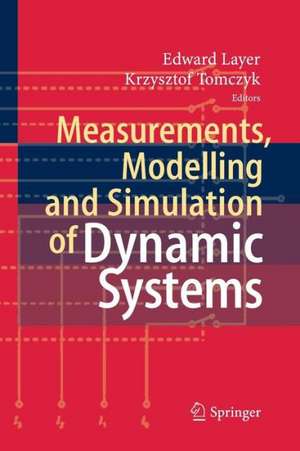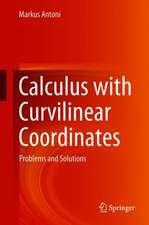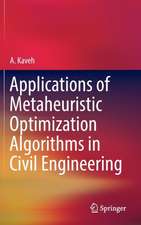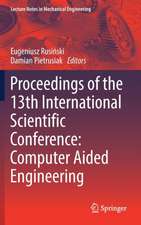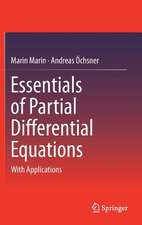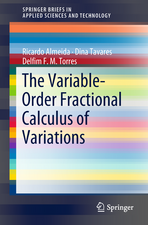Measurements, Modelling and Simulation of Dynamic Systems
Editat de Edward Layer, Krzysztof Tomczyken Limba Engleză Paperback – 7 noi 2014
| Toate formatele și edițiile | Preț | Express |
|---|---|---|
| Paperback (1) | 878.67 lei 6-8 săpt. | |
| Springer Berlin, Heidelberg – 7 noi 2014 | 878.67 lei 6-8 săpt. | |
| Hardback (1) | 733.25 lei 17-23 zile | +63.24 lei 7-13 zile |
| Springer Berlin, Heidelberg – 3 feb 2010 | 733.25 lei 17-23 zile | +63.24 lei 7-13 zile |
Preț: 878.67 lei
Preț vechi: 1071.56 lei
-18% Nou
Puncte Express: 1318
Preț estimativ în valută:
168.13€ • 176.02$ • 139.12£
168.13€ • 176.02$ • 139.12£
Carte tipărită la comandă
Livrare economică 05-19 aprilie
Preluare comenzi: 021 569.72.76
Specificații
ISBN-13: 9783642424656
ISBN-10: 3642424651
Pagini: 168
Ilustrații: XII, 156 p.
Dimensiuni: 155 x 235 x 9 mm
Greutate: 0.25 kg
Ediția:2010
Editura: Springer Berlin, Heidelberg
Colecția Springer
Locul publicării:Berlin, Heidelberg, Germany
ISBN-10: 3642424651
Pagini: 168
Ilustrații: XII, 156 p.
Dimensiuni: 155 x 235 x 9 mm
Greutate: 0.25 kg
Ediția:2010
Editura: Springer Berlin, Heidelberg
Colecția Springer
Locul publicării:Berlin, Heidelberg, Germany
Public țintă
ResearchDescriere
The development and use of models of various objects is becoming a more common practice in recent days. This is due to the ease with which models can be developed and examined through the use of computers and appropriate software. Of those two, the former - high-speed computers - are easily accessible nowadays, and the latter - existing programs - are being updated almost continuously, and at the same time new powerful software is being developed. Usually a model represents correlations between some processes and their interactions, with better or worse quality of representation. It details and characterizes a part of the real world taking into account a structure of phenomena, as well as quantitative and qualitative relations. There are a great variety of models. Modelling is carried out in many diverse fields. All types of natural phenomena in the area of biology, ecology and medicine are possible subjects for modelling. Models stand for and represent technical objects in physics, chemistry, engineering, social events and behaviours in sociology, financial matters, investments and stock markets in economy, strategy and tactics, defence, security and safety in military fields. There is one common point for all models. We expect them to fulfil the validity of prediction. It means that through the analysis of models it is possible to predict phenomena, which may occur in a fragment of the real world represented by a given model. We also expect to be able to predict future reactions to signals from the outside world.
Cuprins
to Measuring Systems.- Sensors.- Methods of Noise Reduction.- Model Development.- Mapping Error.
Recenzii
From the reviews:
“This textbook gives a short introduction to measurements, mathematical modeling, and computer simulation of dynamic systems. The mathematical modeling of dynamic systems is mainly based on systems of linear ordinary differential equations. … This book is divided into 5 chapters. … mainly written for students and researchers in engineering disciplines, who are interested in measurements, mathematical modeling, and computer simulation of dynamic systems.” (Manfred Tasche, Zentralblatt MATH, Vol. 1185, 2010)
“This textbook gives a short introduction to measurements, mathematical modeling, and computer simulation of dynamic systems. The mathematical modeling of dynamic systems is mainly based on systems of linear ordinary differential equations. … This book is divided into 5 chapters. … mainly written for students and researchers in engineering disciplines, who are interested in measurements, mathematical modeling, and computer simulation of dynamic systems.” (Manfred Tasche, Zentralblatt MATH, Vol. 1185, 2010)
Textul de pe ultima copertă
This book discusses an analog-to-digital system intended to dynamic measurement, particularly for non-electrical quantities. The construction and properties of measurement sensors are analyzed in detail, as these represent the primary components for all measurement systems. Procedures for signal noise reduction are presented based on the time window function and a digital Kalman filter. Also covered in this book are the methods of modeling, model development and identification procedures on the basis of measurement data.
The theory of maximum errors is applied in order to determine mapping errors of models in case of non-standard input signals. This is based on signals maximizing the chosen error functional. The existence and attainability of such signals is proved and the algorithms for their determination are presented.
Detailed calculation methods, based on dedicated numerical procedures are demonstrated, which allow the integral-square error as well as the absolute error to be determined.
The problems presented in the book are relevant to a wide range of applications where there is a requirement to determine the accuracy of indeterminate dynamic signals such as occurs in the fields of engineering, medicine, biology, physics etc.
This book will interest researchers, scientists, engineers and graduate students in many disciplines, who make use of measurements, modelling and computer simulation.
The theory of maximum errors is applied in order to determine mapping errors of models in case of non-standard input signals. This is based on signals maximizing the chosen error functional. The existence and attainability of such signals is proved and the algorithms for their determination are presented.
Detailed calculation methods, based on dedicated numerical procedures are demonstrated, which allow the integral-square error as well as the absolute error to be determined.
The problems presented in the book are relevant to a wide range of applications where there is a requirement to determine the accuracy of indeterminate dynamic signals such as occurs in the fields of engineering, medicine, biology, physics etc.
This book will interest researchers, scientists, engineers and graduate students in many disciplines, who make use of measurements, modelling and computer simulation.
Caracteristici
Concise introduction to measuring, modeling and simulation of systems
Includes an overview about various sensors and their application in measurement
Includes an overview about various sensors and their application in measurement
